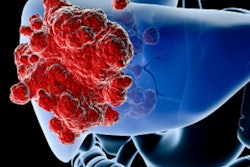
A deep learning-based image reconstruction algorithm outperforms other methods for contrast-enhanced abdominal dual-energy computed tomography (DECT) and could be used routinely in daily clinical practice, according to a recent research study.
A group led by Jingyu Zhong of Shanghai Jiao Tong University School of Medicine in China prospectively evaluated the portal-venous phase images in abdominal DECT of 47 participants with 84 lesions, reconstructing the raw data with traditional reconstruction methods and using deep learning-based image reconstruction at three different strengths. The team found that the deep-learning approach at high strength yielded better results.
"[Deep-learning image reconstruction at high strength] could be safely recommended as a new standard for routine low-keV [virtual monoenergetic image] reconstruction in contrast-enhanced abdominal DECT to provide better lesion conspicuity and better image quality than the standard [adaptive statistical iterative reconstruction technique]," the authors wrote in the article published in European Radiology.
Lesion conspicuity factors
Although prior research has confirmed the potential of deep learning-based image reconstruction for improving image quality and lesion conspicuity in abdominal DECT, the potential factors impacting lesion conspicuity haven't been identified yet. As a result, the researchers ought to evaluate the image quality, diagnostic acceptability, and lesion conspicuity of the technique in comparison with iterative reconstruction.
DECT generates a variety of image reconstructions, such as the virtual monoenergetic image (VMI), which covers a wide range between 40 and 200 kiloelectron volts (keV). The purpose of the reconstructions is to improve iodine attenuation at lower keV levels and reduce beam-hardening artifacts at higher keV levels. VMI at low keV is useful in abdominal imaging, but getting closer to the k-edge of iodine -- 33 keV -- could increase image noise and reduce lesion conspicuity because of lower photon counts.
In the prospective study, raw data were reconstructed to virtual monoenergetic images at 50 keV using filtered back-projection (FBP) -- the standard CT image reconstruction method for several years; adaptive statistical iterative reconstruction-V algorithm at 50% blending (AV-50); and deep learning-based reconstruction at low, medium, and high strength.
Reader study
To reduce the potential bias and variation in their study that could be caused by personal preference in qualitative evaluation, such as diagnostic acceptability and lesion conspicuity, the investigators used five readers who had clinical experience in reading abdominal CT images. They assessed image quality, examining image contrast, image noise, image sharpness, artificial sensation, and diagnostic acceptability. They also evaluated lesion conspicuity.
Moreover, a radiologist with five years of experience in CT image interpretation reassessed all the images and lesions two weeks after the first readout.
The investigators found that deep learning-based image reconstruction reduced image noise compared to AV-50 while better preserving the average noise power spectrum (NPS) frequency. Deep learning-based image reconstruction maintained CT number values and improved the signal-to-noise ratio (SNR) and contrast-to-noise ratio (CNR) compared with AV-50.
Higher image quality
Both high- and medium-strength deep learning-based reconstruction exhibited higher ratings in all image quality analyses than AV-50. The high-strength deep learning-based method also provided significantly better lesion conspicuity than both the AI algorithm at mid-strength and AV-50, regardless of the size of the lesion, relative CT attenuation to surrounding tissue, or clinical purpose, according to the researchers. The two exceptions were for lesions not located in the liver or kidney.
The scientists also indicated that deep learning-based reconstruction is superior to AV-50 in noise reduction, with fewer shifts of the average spatial frequency of NPS toward low frequency, and larger improvements of NPS noise, noise peak, SNR, and CNR values.
It is important for a new image reconstruction algorithm to improve image quality without affecting CT values to allow safe implementation in the clinical setting and for undertaking radiomics analysis, the authors noted. As the algorithm at both mid-strength and high-strength significantly reduced noise and noise peak -- as well as improved the SNR and CNR values compared with AV-50 -- the CT values of eight anatomical sites among different reconstruction algorithms remained stable.
Limitations
But the study has some limitations. It used a relatively small sample size and was conducted at a single institution. A detailed characterization of lesions also wasn't possible. In addition, the real challenge for reconstruction algorithms is low-contrast targets, but the examined lesions had relatively good contrast for detection.
While the scientists suspect that low-contrast subparts in the lesions may further demonstrate the potential of the deep learning-based algorithm for improving the detectability of low-contrast targets, this must be tested when there are enough low-contrast lesions collected for an assessment.
In addition, the investigators only used a blending factor of 50% for Asir-V, based on the routine clinical practice of their institution. Changing the blending factor for Asir-V could impact the results of their study. And the researchers only reconstructed images with a slice thickness of 1.25 mm and did not compare the performance of deep learning-based reconstruction and iterative reconstruction algorithms with different slice thicknesses.
The scientists also noted that the comprehensive evaluation of abdominal diseases needs to be validated in a larger number of cases, and the selection of medium or high strength for deep learning-based reconstruction may have to be fine-tuned for specific clinical tasks.
Nonetheless, they concluded that the method "can be safely implemented in routine clinical settings with stable CT number value and improved image quality, diagnostic acceptability, and lesion conspicuity for abdominal lesions. [Deep learning-based image reconstruction at high strength] could be recommended for routine low-keV VMI reconstruction in daily contrast-enhanced abdominal DECT scans."



















